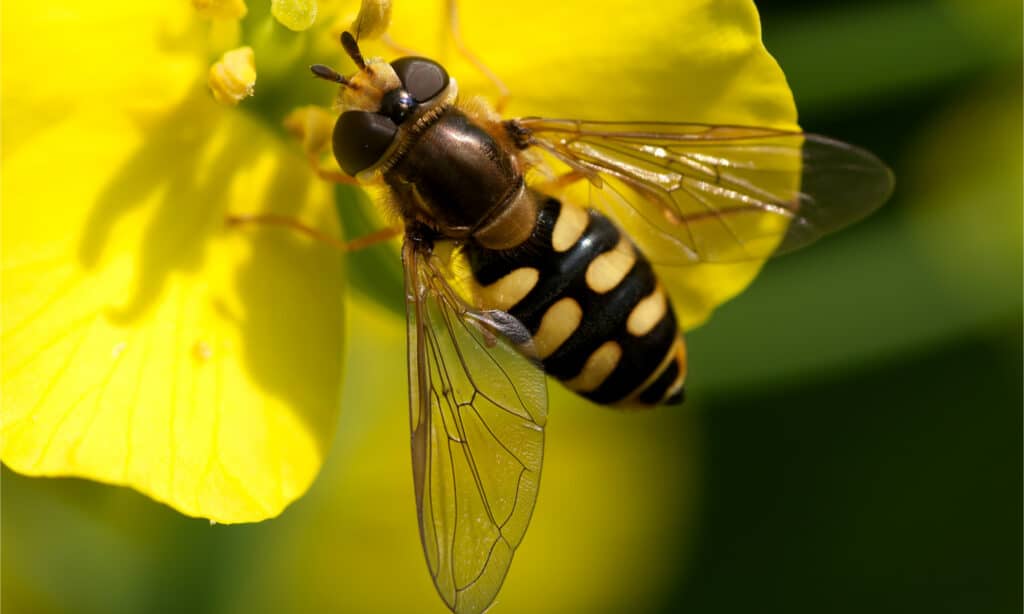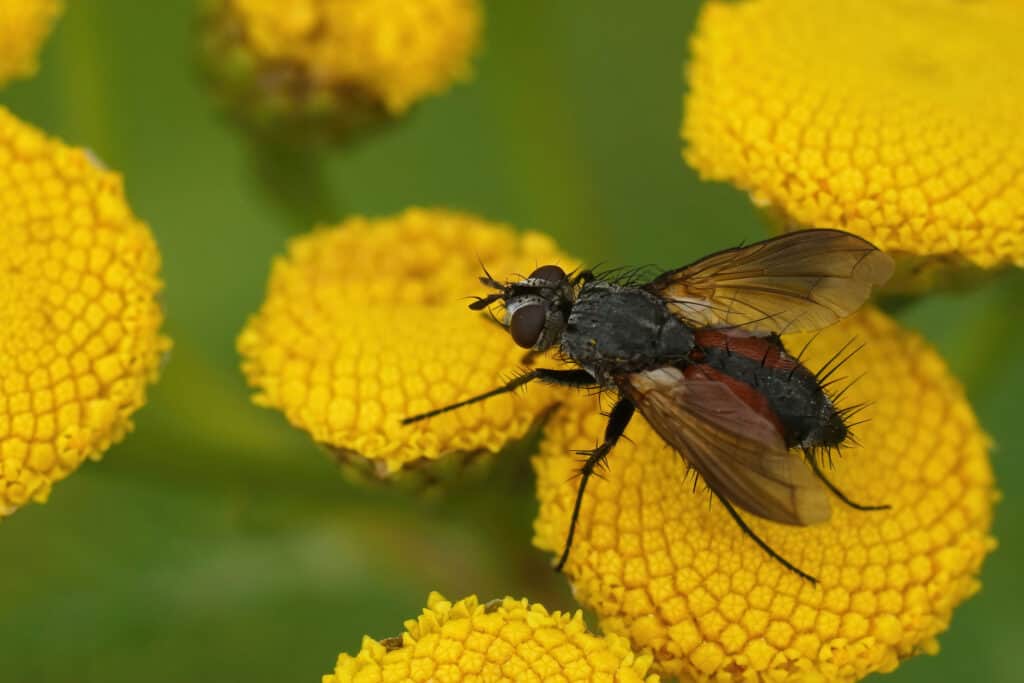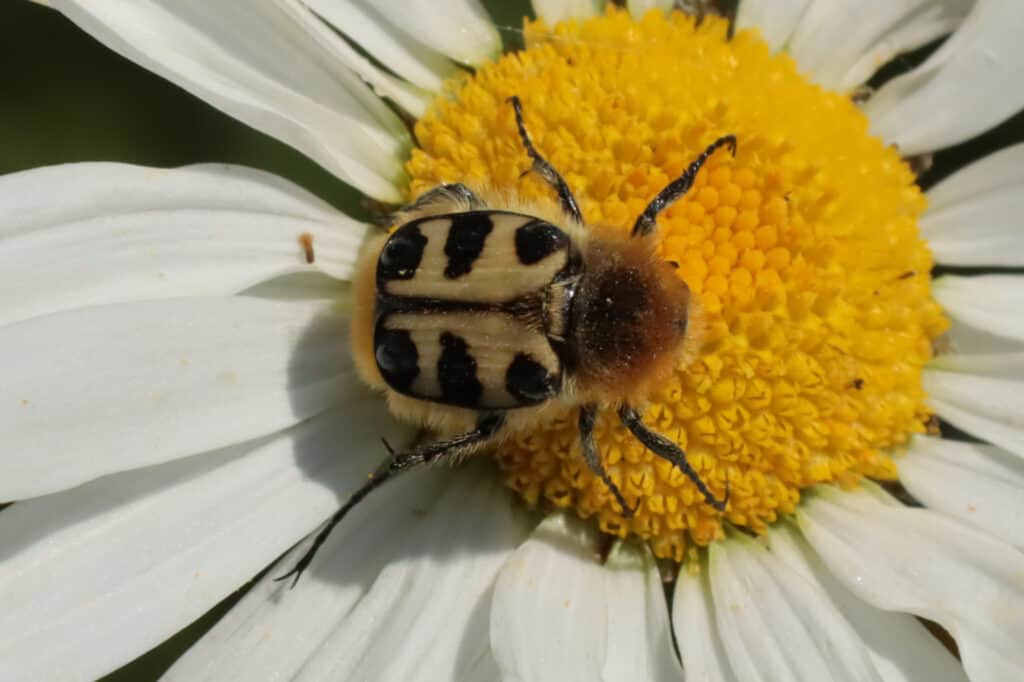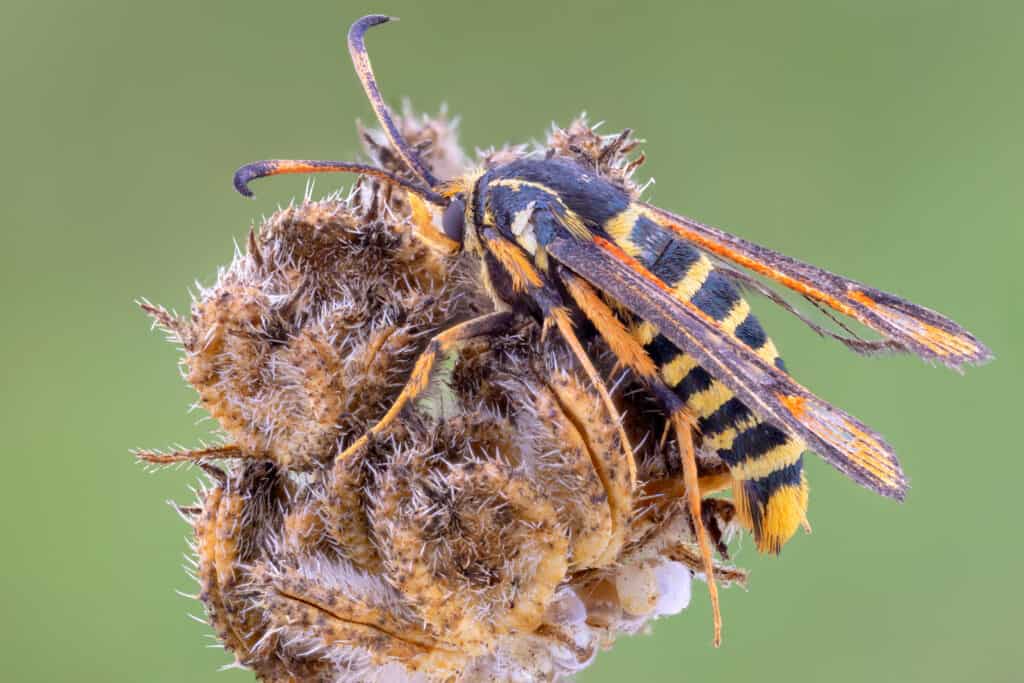Have you ever seen a bee and thought it looked slightly different? Chances are, you may have encountered one of the many insects that look like bees but aren’t actually bees. While technically classified as bugs or flies, bee mimics often have the same color, shape, and even behavior as their buzzing cousins.
However, upon closer inspection, you’ll be able to tell that these imposters aren’t bees at all. Explore this list of 9 bugs and flies that look like bees to learn more about these tiny master mimics!

Flies That Look Like Bees But Aren’t
Flies are characterized by their mobile head, large compound eyes, and mouthparts designed for lapping and sucking. These insects belong to the order Diptera, meaning they have only two wings. Some fly species can be mistaken for bees due to their coloration, marking, and buzzing noise. Some of the bee species mimicked by flies are bumblebees, honeybees, and wool carder bees. Below is a detailed list of some fly species that mimic the appearance of various bees:
1. Hoverflies (Syrphidae)

Hoverflies have large heads with marbled black eyes.
©Johan van Beilen/Shutterstock.com
With yellow and black markings, hoverflies are one of the most convincing bee look-alikes. Their yellow bands are so similar to those of a honeybee! They even mimic the sound created by buzzing honeybees when they flap their wings in flight! As their name suggests, they also hover over flowers and move quickly from one to another — something which honeybees do, too!
However, they cannot sting, making them entirely harmless. Another subtle difference distinguishing them from bumblebees or honeybees is their antennae and number of wings. Hoverflies have short antennae, while most bee species have long antennae. In addition, they have only one pair of wings, while bees have two pairs. Unlike typical bees, hoverflies have large heads with marbled black eyes.
2. Bee Flies (Bombyliidae)

Bee flies have yellow, black, or brown hairy bodies and transparent or patterned wings with dark stripes.
©iStock.com/David Birkenfeld
Bee flies are small insects with stout bodies that look very similar in appearance to brown carder bumblebees or male hairy-footed flower bees. Like bees, they have yellow, black, or brown hairy bodies and transparent or patterned wings with dark stripes. They also have long proboscises, which they use to feed on pollen or nectar from flowers. Unlike bees, which tuck their proboscises when not in use, bee flies keep theirs outstretched.
On the other hand, bee flies don’t have stingers or the ability to make honey and hover in mid-air. Moreover, unlike bees with two pairs of wings, bee flies have only one pair of wings. Another giveaway is their wide waist, shorter antennae, and long, thin legs. They also don’t have mandibles for biting like bees.
3. Parasitic Flies (Tachinidae)

Parasitic flies are known for their unique ability to lay eggs on other insects.
©iStock.com/Wirestock
Parasitic flies are easily mistaken for bumblebees or wool carder bees due to their strikingly yellow side appearance. These insects are important pollinators. Parasitic flies are not called so for nothing. They are known for their unique ability to lay eggs on other insects, such as caterpillars and grasshoppers. Once the eggs hatch and larvae emerge, they feed on their host tissues.
Tachinidae differs from bees in a few ways, such as having bulb-like heads, short antennae, and a single pair of non-folding wings. While bees are hairy, most parasitic flies are bristly-looking. Finally, they have no mandibles, and their waists are wide.
4. Bee Beetle (Trichius fasciatus)

Bee beetles are found in gardens, meadows, and flowery areas, particularly around roses and thyme flowers.
©iStock.com/DE1967
Bee beetles, or Trichius fasciatus, have hairy heads and a yellow and black coloration that makes them resemble carder bees and small bumblebees. Their notable difference from bees is that they have hard forewings that protect their flying wings, while bees have translucent wings. Size-wise, bee beetles are usually smaller than bees. They are found in gardens, meadows, and flowery areas, particularly around roses and thyme flowers.
5. Wasps (Apocrita)

Wasps have two pairs of developed wings.
©Rytis Bernotas/Shutterstock.com
You may wonder how wasps come into the mix. This species of insect is the bee’s closest relative. Similar to bees, wasps have two pairs of developed wings. They also have a narrow ‘waist’ resulting from the constriction between the thorax and abdomen. Bees also have a narrow waist, but a wasp’s waist is even slimmer, giving the insect an overall more streamlined appearance.
Compared to bees, wasps are brightly colored with a broader range of color variations. Wasps lack the dense hair bees have, and their hairs aren’t branched. It’s easy to identify wasps by observing their behavior. To feed their larvae, wasps become scavengers and predators—they hunt for other insects. They also feed on nectar.
6. Yellowjackets or Hornets

Yellowjackets and hornets are both species of wasps.
©Ernie Cooper/Shutterstock.com
The striking resemblance between yellowjackets and hornets can be quite deceiving. They are both species of wasps and have yellow and black stripes, similar to honey bees. However, a close-up observation will reveal some key differences. For one, yellowjackets and hornets lack hairy bodies like the honey bee and feature a more glossy texture.
Another notable difference between them is their size. In addition to that, they have no pollen baskets. Also, in terms of behavior, yellowjacket, and hornets are aggressive and can sting you multiple times without provocation. In contrast, honey bees are docile creatures and only sting when threatened. Unlike bees, yellowjackets and hornets not only depend on nectar but also prey on smaller insects.
7. Cicada Killers (Sphecius)

Cicada killers are solitary wasps characterized by their glossy, long, and ovate black bodies with yellow bands.
©samray/Shutterstock.com
If you see a large, solitary wasp flying around your yard, it’s likely a cicada killer. As their name suggests, they prey on cicadas, which they then use to provision their nests. Cicada killers are solitary wasps characterized by their glossy, long, and ovate black bodies with yellow bands. The most glaring difference between cicada killers and bees is that the former has brick-red eyes, red-orangish legs, and one pair of light brown wings. Though females have a stinger, cicada killers are not aggressive toward humans, and females only sting if provoked. In contrast to wasps and honey bees, they do not have nest-guarding instincts.
8. Common Drone Flies (Eristalis tenax)

Common drone flies have a single pair of wings.
©iStock.com/Wirestock
This bee mimic is often mistaken for a small honeybee, thanks to its fuzzy body and brown and yellow-orange markings. You can usually spot this fly hovering near brightly-colored flowers, feeding on flower nectar. Another physical trait that makes it hard to tell a common drone fly from a honey bee is the dark brown coloring that both insects share. However, these mimicry specialists have a single pair of wings, while honeybees have two. Another key difference is that male drone flies have larger compound eyes than honeybees.
9. Raspberry Crown Borers (Pennisetia marginata)

The raspberry crown borer is a type of moth with yellow and black stripes on its body.
©ozgur kerem bulur/Shutterstock.com
The raspberry crown borer may look like a bee, but it’s actually a type of moth with yellow and black stripes. Like bees, moths have bodies covered in dense hairs. One difference between them is that the raspberry crown borers have feathered antennae despite their slender bee-like appearance. It is also easy to spot a raspberry crown borer since its wings rest at its side, whereas a bee’s wings are flat on its body. This unique feature helps the moth protect itself from predators, making it look like a wasp or yellowjacket rather than a moth.
What Flies Sting Humans?

The aggressive deer fly is the number one blood-sucking fly in the U.S. in the summer months.
©Vinicius R. Souza/Shutterstock.com
While stinging bees tend to attract the focus of humans as stinging bugs to fear, there are certain flies that can bite or sting. While they are typically not dangerous, they can certainly cause pain. Here are five stinging or biting flies to be aware of.
- Horse Flies Horse flies are not only intimidating for their size–from ¾ to 1 ¼ inches long–but they are aggressive and can exact painful bites on humans. While they don’t usually carry diseases, their bites can cause allergic reactions in some people. This type of fly will repeatedly bite if it is able to draw and taste blood. Female varieties will even chase their targets. Ways to repel these tiny beasts include using insect repellent or wearing light-colored clothes.
- Sand Flies Though sand flies are very small, measuring a quarter the size of a mosquito, their bites can produce blisters or small red welts that can itch or swell. It is possible for these creatures to carry parasitic diseases like leishmaniasis. This condition is usually contracted in places outside the U.S., but some cases have been reported in Oklahoma and Texas.
- Deer Flies Deer flies are a very aggressive fly species that delivers painful bites. Their mouths feature razor-like lips which can slice skin to feed on the blood. Some people have allergic reactions to the bites. The USDA warns that these flies are the chief bloodsuckers during summer months in the U.S. They are capable of carrying Tularemia (rabbit fever), which would need treatments with antibiotics.
- Black Flies Also referred to as buffalo gnats, these flies are common in the U.S. and also slash the skin to feed on blood. Fortunately, they don’t usually transmit diseases. Their bites create a scab, and some people experience an itchy welt growing from it. If the latter occurs, the victim could develop “black fly fever,” characterized by nausea, headaches, fever, or swollen lymph nodes.
- Biting Midges These flies are referred to loosely as gnats, but also called “no-see-ums” due to their tiny size. A bite from one can result in a blister or red welt that itches. These flies do suck blood, and the bite delivers a painful sting. They can transmit Mansonella ozzardi, a parasite that could produce flu-like symptoms in the victim.
Summary of 9 Bugs and Flies That Look Like Bees
| # | Bee-like Bug | What Kind of Bug is It? |
|---|---|---|
| 1 | Hoverflies | Type of fly |
| 2 | Bee Flies | Type of fly |
| 3 | Parasitic Flies | Type of fly |
| 4 | Bee Beetle | Beetle |
| 5 | Wasps | Wasp |
| 6 | Yellowjackets or Hornets | Type of wasp |
| 7 | Cicada Killers | Type of wasp |
| 8 | Common Drone Flies | Type of fly |
| 9 | Raspberry Crown Borers | Type of moth |
The photo featured at the top of this post is © MRS. NUCH SRIBUANOY/Shutterstock.com
Sources
- North Dakota State University Extension, Available here: https://www.ndsu.edu/agriculture/extension/publications/insects-look-bees
- Michigan State University Extension, Available here: https://www.canr.msu.edu/news/insects-that-look-like-bees
- Farm Food Family, Available here: https://farmfoodfamily.com/flies-that-look-like-bees/
- Bee Spotter, Available here: https://beespotter.org/topics/mimics/
Thank you for reading! Have some feedback for us? Contact the AZ Animals editorial team.






